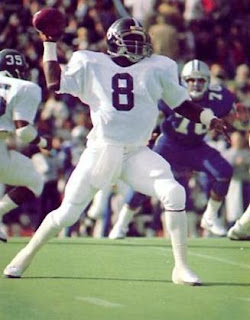Ice-T, accountants, dreamers and football
There are two types of debaters in the I-A/I-AA argument, and I don't mean those who are for moving up and those who are for staying put. I call them the "heads" and "hearts." Timing, not the record industry's in-depth research or an overwhelming belief that Body Count was going to make musical history, led to "Cop Killer" being the second most important song of the early 1990s (the first, obviously, was "Smells Like Teen Spirit"). Also worth noting, Ice-T now plays a cop on television.
The first type is composed of people who make every one of their points based on facts and figures. I suspect a good number of them are lawyers and accountants, although I have no way of knowing for sure. What is obvious is that this demographic of message board advocate has access to every school's athletic budget from 1863 to the present, they know the exact cost to fly a women's volleyball team from Fayetteville, Arkansas to Lake Charles, Louisiana, and they actually read and understand the minutes from the Division I Management Council's June meeting as reported in the NCAA News. I admire these people because of their ability to track down real and verifiable information. They also scare me, because they are the types of folks who could get on Google and compile a list of every woman I've ever slept with, forward it to my fiancé and then post the resulting apocalypse on YouTube. Not good.
The second type of debater is less concerned with hard facts and figures. This type of GSU fan relies more on anecdotal evidence and believes in the power of persistence and the strength of human resolve. Among Eagle fans, this subculture has a devotion to the school's meteoric initial rise to football prominence that borders on belief in the mystical. Some, I think, keep Eagle Creek water handy the way Borat holds on to gypsy tears. This isn't to say that they are unaware of the facts and figures, just that they consciously believe that every else's situation is irrelevant (or at least inconsequential). If I admire the "heads" then I truly love the "hearts." These people were English majors, they drink to excess (or smoke pot) and they cried at the end of the Western Kentucky game in 2002.
What makes this particular dividing line so humorous (or maybe even ironic) is that people with completely different agendas can end up in the same group. One "head" can say Georgia Southern's facilities are rapidly improving and outpacing the rest of I-AA, pointing to the comparative age, cost, square footage, etc. of football stadiums, weight rooms, baseball facilities—you get the picture. Another head might argue that GSU is woefully unprepared for I-A because of how far behind even Mid-major I-A schools GSU is in facilities—using the exact same information.
I say this because the "head" versus "heart" camps don't divide GSU fans by whether they think the school should move up in classification. They divide the fan based on why they hold their beliefs. It goes back to the last blog entry about pride and institutional status, except that the status issue is a "why" for the institution. Head and heart are a "why" for the individuals, including the decision makers.
They are both wrong.
And right.
How anyone thinks about framing the reclassification debate is far less important than how anyone on any side of the issue understands the matter of timing. Bear with me for one and a half medium-length paragraphs: In 1991, Tipper Gore and the PMRC (and later every politician in America) had something to say about the song "Cop Killer" by Ice-T and Body Count. One song thrust a band that played before Siouxsie and the Banshees at the first Lollapalooza into the national spotlight more than Jane's Addiction, the band that headlined that groundbreaking tour. Now, had Ice-T put together his metal/rap fusion band in 1986, (a) no one would have heard it except speed metal kids that went to Slayer concerts and (b) with no election that year, the politico would have ignored it, too: no backdoor exposure, either. If the album had been released in 1996, the tracks would have been rendered irrelevant by either the emergent Gangsta Rap or by superior musicians working in a similar vein like Rage Against the Machine. But "Cop Killer" hit in the summer of '91 and shortly afterwards there was a major riot in Los Angeles that had more to do with opportunism among the socio-economically downtrodden (who happened to be, in L.A., black, like Body Count) than it did with race. Still, white people got nervous and blamed "Cop Killer." An entire election was influenced by a song that was really nothing more than theater (I owned the CD and understood the underlying thematic elements therein—I assure you Ice was not advocating anti-authoritarian homicide) and a third rate (yet kick-ass) band sold a ton of units.
In 1991, Tipper Gore and the PMRC (and later every politician in America) had something to say about the song "Cop Killer" by Ice-T and Body Count. One song thrust a band that played before Siouxsie and the Banshees at the first Lollapalooza into the national spotlight more than Jane's Addiction, the band that headlined that groundbreaking tour. Now, had Ice-T put together his metal/rap fusion band in 1986, (a) no one would have heard it except speed metal kids that went to Slayer concerts and (b) with no election that year, the politico would have ignored it, too: no backdoor exposure, either. If the album had been released in 1996, the tracks would have been rendered irrelevant by either the emergent Gangsta Rap or by superior musicians working in a similar vein like Rage Against the Machine. But "Cop Killer" hit in the summer of '91 and shortly afterwards there was a major riot in Los Angeles that had more to do with opportunism among the socio-economically downtrodden (who happened to be, in L.A., black, like Body Count) than it did with race. Still, white people got nervous and blamed "Cop Killer." An entire election was influenced by a song that was really nothing more than theater (I owned the CD and understood the underlying thematic elements therein—I assure you Ice was not advocating anti-authoritarian homicide) and a third rate (yet kick-ass) band sold a ton of units.
Of course, Georgia Southern's look at reclassification in no way hits the cultural radar like a Katrina-esque collision of American values and American reality, but it illustrates how one well-timed (or poorly-timed, depending) event can shape the way events move more than all the strategic planning and obsessing and hoping and believing can. This is why I've moved from the stance that dominating I-AA is good enough for Georgia Southern to the opinion that it looks like time to head for higher ground.
You see, in 2004 when the Statesboro Herald reported about the potential benefits and pitfalls of moving GSU up the ladder, the NCAA was mulling a number of I-A/I-AA problems. First, a lot of schools on the back end of I-A were really, really sucking out loud. They were struggling to meet the attendance minimum (15,000 per home game). They were hemorrhaging money. They were shut out of the BCS, which was the really big money in college football. Second, I-AA had been losing teams right and left since 1990 and more appeared to be planning to jump ship. Third, I-AA had a ceiling (63 scholarships) but no floor (some I-AAs weren't funding any scholarships), robbing the division of a large degree of legitimacy. Fourth, from everyday schmucks to broadcasters, people were confusing I-AA with Division II. Even I-AA coaches referred to I-A as "Division I." Not good. Fifth, despite being the highest level of NCAA football with a real championship, I-AA was playing its championship on a Friday night when the D-II title was on Saturday afternoon in a better time slot.
Jesus wept.
The talk around the campfire in 2004 was that the NCAA was going to fix these problems. They would tighten the line between I-A and I-AA. They would boost exposure for the subdivision through expanded playoff coverage and season-long support. They would clarify that I-AA was Division I. Some naïve folks even believed the NCAA might send some of the poseurs back down from I-A to I-AA.
It didn't happen.
What DID happen was that the BCS absorbed every I-A league to appease some rabble-rousing Mid-majors (can you hear me, Tulane?). Then Boise State, a former I-AA champion and a I-A Mid-major, beat Oklahoma in the most memorable BCS game of 2006, solidifying the resolve of every Mid-major to get onto the really, really big stage PLUS encouraging everyone from Western Kentucky to Wyoming Hair and Nail College to aim for I-A status and glory. Yes, the NCAA got more playoff coverage for I-AA, but the shitty Friday night title game remained and the name change… hold on, I'm choking back rage… let's just say the name change sucked.
If people couldn't figure out that I-AA was part of Division I, how in the hell are they supposed to know that the FCS is?!? The former I-A schools don't have to struggle with brand identity. You could call them NASCAR and even casual fans would know that Michigan is one of the big boys.
(Quick aside: does anyone think Middle Tennessee State and its ilk are a little pissed off at having to explain that FBS is also Division I? Didn't the lower third of I-A also get hosed? Probably, but it is still better to get hosed by the big boys when you are in their division than to get hosed and not even have a semantic leg to stand on.)
So why should Georgia Southern pick now to head to the FBS?
If 13 teams reclassified from I-AA to I-A from 1995 to 2002, the next big exodus could be on the way. Teams like Youngstown State, Montana, McNeese, Appalachian State, Delaware, UMass and others could be on the way out the door. After all, for marginally successful I-AA teams, the jump is more about sucking up the added expenses than the actual intricacies of moving up. Most of the schools above already pass a 15,000 attendance requirement and more than a few are on the cusp of FBS standards already. If many more I-AA programs with name recognition move up, it would be terrible for Georgia Southern. The Eagles would be left with no divisional contemporaries. For I-AA to be a viable source of continued institutional visibility, then I-AA or FCS or whatever the hell you're going to call it, has to have a defined and strong upper crust.
Remember, without the joker, Batman is just a lunatic in tights.
Not only does staying in I-AA with major rivals gone look unappealing, it discounts another very real possibility. The next time the BCS has some flexibility, the major conferences (plus Notre Dame) may decide to sever themselves from the NCAA altogether, leaving a smaller pool to share bowl money and television revenues. In effect, that move would create another subclass—the BCS and Division I. That, I-AA fans, leaves FCS (then, essentially, a third tier of D-I) looking a lot like Division II. Being on the wrong side of that line could be terrible.
Even if the BCS/Division I scenario doesn't play out, it is a bit like Paschal's Wager. It is better to guess that the atmosphere in college football will be turbulent and ally yourself with the FBS schools. If you are wrong, yet maintain a decent standing among FBS schools, you still have a nice program to enjoy. But if GSU decides to stay in the FCS and the BCS really does break away, what the school loses is far more than it would gain by staying put if FBS and FCS lived in harmony together forever.
It is also worth noting for both the "head" and "heart" crowd that while He Who Must Not Be Named (or, to carry the Harry Potter thing out, Brian VanGoldermort) may have isolated fans and been the key ingredient in a 3-8 season, his very presence briefly energized GSU football. New facilities and facility improvements sprung up (many were already in the works, granted), interest in the program grew and for the first time in a while, monetary sources seemed to spring up from nowhere and the program seemed to have a legitimate forward motion (alas, until Central Connecticut State). The "heart" people will tell you that this proves the "if you build it, they will donate" model. I think it proves that if you show you are serious about doing something right (and let's face it, that was the impression the BVG hire gave), others will step up and help you do it right. Just coming up with the coaching salary it took to hire BVG proved a point about big donors coming off the Benjamins.
BVG also put a face on some infrastructure building. I'm not sure just how closely he was tied to the new Bishop building (out of the loop for that segment of GSU history), but his presence sure seemed to fast-track it. And other immediate improvements to facilities can be directly tied to him. The man may not have understood the need to establish the run or how to use his best player, but he did understand what good football programs looked like in terms of brick and mortar.
Another word on timing:
I can't remember ever seeing as many butts in the seats at Georgia Southern's annual Blue-White spring game as I saw this year. Good sign. If 1996 was the Year We Pretend Never Happened, then 2006 will have to go down as the Year A Knee-Jerk Reaction Goddamn Nearly Erased Twenty-Five Years of Tradition. So to see Chris Hatcher come in and restore order, faith and (most importantly) excitement in Eagle football so quickly is a huge relief. Hell, he can go 6-5 next year and I'll be the first guy in line to give him a pass. 5-6 and I'll still probably be fifth or sixth.
One odd moment from spring football, though: I heard some of my old media buddies refer to Hatcher's tactic of having the players erase all mentions of Georgia Southern from their uniforms (down to wearing jerseys inside out) as a "high school" move. Those folks couldn't be more wrong. The idea of starting over is not just central to the football players, but it is incredibly important to the fans and probably crucial to the renewed success of GSU football.
First, Erk Russell and his Eagles made winning a collegiate championship in Division I look ridiculously easy. This lead to the sort of fan expectations that make athletic directors into perpetual chumps. Any non-championship season is suddenly a failure. In any sport. Second, and more importantly, the 1985 title reaffirmed the decision to start football at GSU and set the precedent that anything (and I mean anything) was possible. Obviously, you could start from scratch and build a champion in no time, right? What else could you do?
The Year We Pretend Never Happened didn't really do a lot to shake up the unbridled optimism in GSU football (although judging by the attendance from 1992 to 1996, a lot of that optimism was being kept at home anyway) because everyone knew that Frank Ellwood was an interim coach keeping the house in order until reinforcements could arrive. The Knee-Jerk Year, on the other hand, really shook people up. Mike Sewak may have had his detractors, but dammit, he loved Georgia Southern football. When he was replaced by He Who Shall Not Be Named it was obvious that a shake-up was taking place. I'll be getting to the P.R. nightmares in the next piece. In the meantime, after a single, sad, 3-8 year—well, let's just say that the whole season still doesn't feel quite real—the One Man Wrecking Machine (with apologies to Guster) headed back from whence he came. Popular NFL writer Gregg Easterbrook might have reasoned that the Football Gods, seeing the hubris of Georgia Southern football fans, sent BVG as a punishment and a reminder to Georgia Southern fans, who may not have appreciated 2002, 2004 and 2005 enough. Again I digress. The point is that BCG was a huge change in direction, and although he more than successfully completed the demolition phase of the GSU renovation, he was gone before most folks could even get a handle on what the blueprint for the new Eagles looked like.
The reason newly crowned head coach Chris Hatcher's so-called "high school" tactics are anything but is because with just over 25 years of history to draw upon, Georgia Southern fans aren't really sure how to deal with this latest setback. After all, it isn't as though the school had hired some stiff in December of 2005 (I mean, they did, but almost no one thought so at the time). They hired a coach with a seemingly unlimited ceiling and he just fell on his face (with the exception of showing that people would give large sums of money to GSU just to have a tangible sign of commitment to a move forward). The administration followed up the BVG fiasco not by hiring a new coach who would re-install the option and go back to the status quo. Nope. Hatcher's Eagles are going to throw the ball, they're going to use a "rover" on defense and they are generally going to look a great deal like BVG's Eagles, only with some offensive competence, we hope. To make all of this a little more palatable (and to make sure that season ticket sales figures at GSU don't look like they came from East Tennessee State) Hatcher brilliantly tapped into the Eagles' oldest tradition—making something from nothing. Of course, Hatcher has infinitely more at his disposal than Erk did (like footballs… and players… and a stadium), so the whole reinvention thing had to be symbolic. It also has to be palpable enough to bring out the fans. Judging by the spring game, the idea is an early success.
No matter how hard the new coaching staff might try to reinvent Georgia Southern football from the ground up, the fact remains that since the Statesboro Herald ran a series of articles about the I-A/I-AA debate in 2004, the school has done a remarkable job of positioning itself for just such a move, even if athletic director Sam Baker won't say as much. Stadium improvements, the new track facility, other infrastructure—say what you will about Baker, but the man could have been a general contractor.
So some fans have gone as far as to say "why not start towards I-A if we're already starting over?"
Consider South Florida, who rode big donations and huge student fees from I-AA in 1997 and 1998 to I-A and eventually the Big East. In the process of doing the Herald story in 2004, I learned you just really can't compare two schools unless they are remarkably similar, but it is hard not to figure that a school like Georgia Southern should in some way be able to parlay 25 years and six I-AA championships into something successful if South friggin' Florida, a notorious commuter school with no football history before 1997, can move from zilch to I-A in two years. There is the small matter of USF getting its ass handed to it on a platter for several years while the Bulls played unwinnable money games, which GSU fans would not likely take well. South Florida fans sucked it up because USF didn't win the I-AA championship in 1998 (which would have paralleled GSU's '85 title). They didn't know any better.
Georgia Southern never really had to pay any dues for its success, at least not in the eyes of the casual fan. The Eagle football program was lightning in a bottle from day one. Moving up to I-A seemed counter-intuitive in the face of six national championships in I-AA, and I'll go on record as saying that if FCS football was in 2007 what I-AA was in 1989, then the Eagles should unequivocally stay put. In '89, a lot of really good teams with real football roots were all in I-AA: Nevada, Middle Tennessee, Marshall, Central Florida, Idaho, the Louisiana Directional Schools. If those teams had stayed put and the NCAA had encouraged I-AA to grow within itself rather than the through an immigration crisis, the division would be really exciting. Unfortunately, the prospects look pretty dim.
Considering that the Eagles are coming off of two straight bummer years (four if you think the loss to New Hampshire in 2004 ruined an otherwise incredible season—I don't), including the Mother of All Bummer Years, and considering that the new Eagle coach might just be the kind of guy who can say and do the right things during a period of transition and considering that the NCAA has absolutely no testicular fortitude vis-à-vis Division I football, it's plain even to me, a fully fledged I-AA apologist, that the time has come to head for higher ground.
Of course, to do so takes money. And to get money means every Eagle fan needs to be on the same page, which means the school has to do a fantastic job of communicating with said fans. Public relations, however, isn't the athletic department's strong suit.
Later this week: The truth about PR, why SouthernFACTS is a godsend (that just needs a little tweaking) and how to make hot girls go home with you. Just kidding about the last part. Wanted to see if you were still paying attention after 3500 words.







|